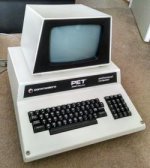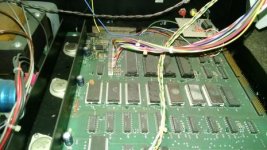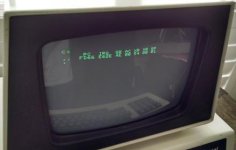CommodoreZ
Experienced Member
I had the fortune of acquiring a PET 2001-32N recently in functioning condition. Needless to say I'm happy to have one! However, I have plenty to learn since this is my first extensive interaction. I can enter stuff into BASIC which runs fine, but I have yet to exhaustively test it (more on why I haven't later).

Click for larger version
Seems it has a few modifications made to it, including what kinda looks like a current loop interface. My knowledge of current loops is admittedly very limited. I'm curious if anyone could clue me in about why exactly it's hooked in this way with banana clips. Keeping in mind that there's only 40 columns available, I have no idea what they would want to interface with.
It also has plenty of tape covering up the card-edge connectors, plus a pair of screws securing the chassis closed. The cosmetic wear has me guessing that this was used in a school or office where they didn't want folks to be able to open it. It has a single button installed on the front panel where the C= logo was, which brings up the text pictured on the screen in the last image. Any idea why someone install a button like that?

Click for larger version
The main thing that concerns me is the lack of responsiveness from some keys of the keyboard. A few keys like both shifts seem entirely dead (shift-lock works for the moment), and others require very hard keystrokes (or multiple presses) to produce a character on screen. Is repairing the keyboard a possibility or do I have to replace it?
One last thing: I'm trying to decide what avenue I should pursue for data storage. Obviously there are floppy disks, but I'm not familiar with which FDD models are the preferred choices -- there are so many! Plus there is the classic external dataset. But an easier place to start would be something that would let me pull software images from a modern computers. I've seen versions for later Commodore machines, but never PET/CBM era stuff.

Click for larger version

Click for larger version

Click for larger version
Seems it has a few modifications made to it, including what kinda looks like a current loop interface. My knowledge of current loops is admittedly very limited. I'm curious if anyone could clue me in about why exactly it's hooked in this way with banana clips. Keeping in mind that there's only 40 columns available, I have no idea what they would want to interface with.
It also has plenty of tape covering up the card-edge connectors, plus a pair of screws securing the chassis closed. The cosmetic wear has me guessing that this was used in a school or office where they didn't want folks to be able to open it. It has a single button installed on the front panel where the C= logo was, which brings up the text pictured on the screen in the last image. Any idea why someone install a button like that?

Click for larger version
The main thing that concerns me is the lack of responsiveness from some keys of the keyboard. A few keys like both shifts seem entirely dead (shift-lock works for the moment), and others require very hard keystrokes (or multiple presses) to produce a character on screen. Is repairing the keyboard a possibility or do I have to replace it?
One last thing: I'm trying to decide what avenue I should pursue for data storage. Obviously there are floppy disks, but I'm not familiar with which FDD models are the preferred choices -- there are so many! Plus there is the classic external dataset. But an easier place to start would be something that would let me pull software images from a modern computers. I've seen versions for later Commodore machines, but never PET/CBM era stuff.

Click for larger version

Click for larger version
